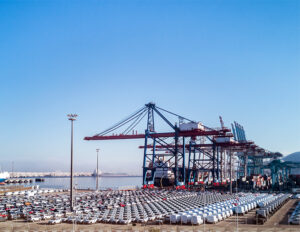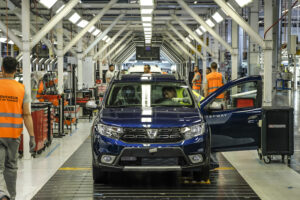Morocco’s auto industry takes pole position in electrical vehicles

Already Africa’s largest producer of passenger vehicles, the country’s automotive industry is expanding rapidly thanks to its proximity to Europe, plus huge investment in transport infrastructure and renewable energy.
SHARE THIS ARTICLE:

Within the last two decades, Morocco’s automotive sector has become a global force—the country currently manufactures around 700,000 vehicles a year, is the largest African producer of cars and has the 19th largest actual production worldwide, according to the International Organization of Motor Vehicle Manufacturers. Today, more than 250 businesses operate across the sector’s value chain, with 90 percent of their output—valued at $8.3 billion annually—being exported to over 70 countries.
Many of those companies are leading international players, explains Mohamed Bachiri, managing director of Renault Group Morocco: “Positioned as a gateway to Europe, the Middle East and Africa, Morocco represents a highly attractive destination for investors with high added values.”
Renault and fellow manufacturing giant Stellantis form the backbone of an automotive ecosystem that is constantly being strengthened by new arrivals, adds Bachiri, who highlights the government’s huge infrastructural investment in “world-class port facilities, roads, railways, free zones and clean energy” as one crucial reason for this.
A standout attraction for exporters is Tanger Med Port, ranked by Lloyd’s List as the largest container port in Africa and the Mediterranean. Connected to 77 countries, Tanger Med is just 9 miles from Europe, enabling competitively priced shipments from Morocco to reach Germany at the heart of the continent within 72 hours.
That ease of access—coupled with free trade agreements with over 50 countries covering the European Union (EU), the U.K., the U.S., Africa and Middle Eastern countries—is boosting Morocco’s importance for firms looking to shorten supply chains into Europe and those adapting to chain disruptions. For instance, earlier this year, German wiring and harness specialist Leoni revealed it was moving some of its Ukrainian operations to its Moroccan plants to secure supply.
Companies also benefit from being based in Morocco’s industrial zones, seven of which are dedicated to the automotive industry. These zones are well integrated into a transportation network that includes 18 airports, over 1,120 miles of highways and Africa’s first high-speed train line. Additionally, they offer incentives such as a 100-percent exemption from corporate income tax for the first five years of operation.

Copyright: David Templier
Another core asset is the country’s pioneering approach to green energy and proven capabilities in decarbonizing industries. The government has invested $6 billion in renewables so far, 37 percent of Morocco’s energy capacity was based on green sources in 2020 and that is due to rise to 52 percent by 2030. A good illustration of the sector taking advantage of this is Renault, which has two Moroccan plants that produce 11 percent of the total vehicles sold by the group globally. Renault opened its second facility in 2012. “It’s the largest automotive plant in Africa and the world’s first environmentally friendly plant: there’s no effluent discharge and it’s carbon neutral,” says Bachiri.
As a champion for low-carbon industry, the country is set to become a hub for electric vehicles (EVs), with two models already being made in Morocco. In 2020, Stellantis’ Citroën Ami became the first electric car to be produced in North Africa and, this April, the group launched the Opel Rocks-e. This locally designed two-seater is produced at Stellantis’ Kenitra plant, which already manufactures the Citroën Ami and the Peugeot 208, and is initially being marketed in Europe. At the car’s unveiling, the group’s chief operating officer for the Middle East and Africa, Samir Cherfran, stressed that its production in Morocco would “benefit from an ecosystem of local suppliers.”
“Positioned as a gateway to Europe, the Middle East and Africa, Morocco represents a highly attractive destination for investors with high added values.”
Both Stellantis and Renault are strongly supported by that ecosystem. The former currently sources 60 percent of its parts and components from firms in Morocco, while Renault has achieved 64 percent and 76 of its tier 1 suppliers are now present in the country. Both are also confident that, as the sector is growing so quickly, they will reach local integration rates of 80 percent by 2025.
A few of the latest inward investments confirm the nation’s increasing status as a platform for production and export in low-carbon mobility. For example, Japan’s Yazaki is extending its EV wiring production capacities, Sumitomo is expanding its electric harness facility, and U.S. seating and electrical systems supplier Lear is adding to its 11 existing Moroccan factories by creating a new one for electric cabling. Also in 2022, STMicroelectronics inaugurated a $244-million extension to its plant that will produce Tesla microchips, and Reuters reported that the government was in negotiations with EV battery manufacturers to build a gigafactory.
Morocco’s government has laid out a roadmap for the ongoing advance of the industry that includes fully decarbonizing operations and ramping up annual production to 1 million vehicles. Bachiri is optimistic about the future: “The conditions for success are in place to continue the development of the country’s industrial sectors and, in particular, its automotive sector.”

